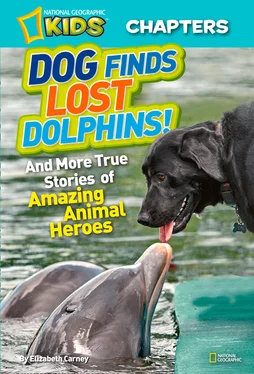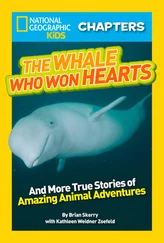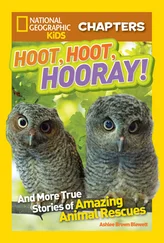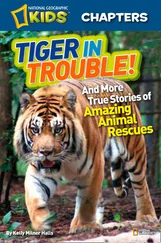Elizabeth Carney - National Geographic Kids Chapters - Dog Finds Lost Dolphins - And More True Stories of Amazing Animal Heroes
Здесь есть возможность читать онлайн «Elizabeth Carney - National Geographic Kids Chapters - Dog Finds Lost Dolphins - And More True Stories of Amazing Animal Heroes» — ознакомительный отрывок электронной книги совершенно бесплатно, а после прочтения отрывка купить полную версию. В некоторых случаях можно слушать аудио, скачать через торрент в формате fb2 и присутствует краткое содержание. Жанр: unrecognised, на английском языке. Описание произведения, (предисловие) а так же отзывы посетителей доступны на портале библиотеки ЛибКат.
- Название:National Geographic Kids Chapters: Dog Finds Lost Dolphins: And More True Stories of Amazing Animal Heroes
- Автор:
- Жанр:
- Год:неизвестен
- ISBN:нет данных
- Рейтинг книги:4 / 5. Голосов: 1
-
Избранное:Добавить в избранное
- Отзывы:
-
Ваша оценка:
- 80
- 1
- 2
- 3
- 4
- 5
National Geographic Kids Chapters: Dog Finds Lost Dolphins: And More True Stories of Amazing Animal Heroes: краткое содержание, описание и аннотация
Предлагаем к чтению аннотацию, описание, краткое содержание или предисловие (зависит от того, что написал сам автор книги «National Geographic Kids Chapters: Dog Finds Lost Dolphins: And More True Stories of Amazing Animal Heroes»). Если вы не нашли необходимую информацию о книге — напишите в комментариях, мы постараемся отыскать её.
National Geographic Kids Chapters: Dog Finds Lost Dolphins: And More True Stories of Amazing Animal Heroes — читать онлайн ознакомительный отрывок
Ниже представлен текст книги, разбитый по страницам. Система сохранения места последней прочитанной страницы, позволяет с удобством читать онлайн бесплатно книгу «National Geographic Kids Chapters: Dog Finds Lost Dolphins: And More True Stories of Amazing Animal Heroes», без необходимости каждый раз заново искать на чём Вы остановились. Поставьте закладку, и сможете в любой момент перейти на страницу, на которой закончили чтение.
Интервал:
Закладка:

Copyright © 2012 National Geographic Society
All rights reserved. Reproduction of the whole or any part of the contents without written permission from the publisher is prohibited.
Published by the National Geographic Society
John M. Fahey, Jr., Chairman of the Board and Chief Executive Officer
Timothy T. Kelly , President
Declan Moore, Executive Vice President; President, Publishing and Digital Media
Melina Gerosa Bellows, Executive Vice President; Chief Creative Officer, Books, Kids, and Family
Prepared by the Book Division
Hector Sierra, Senior Vice President and General Manager
Nancy Laties Feresten, Senior Vice President, Editor in Chief, Children’s Books
Jonathan Halling, Design Director, Books and Children’s Publishing
Jay Sumner, Director of Photography, Children’s Publishing
Jennifer Emmett, Editorial Director, Children’s Books
Eva Absher-Schantz, Managing Art Director, Children’s Books
Carl Mehler, Director of Maps
R. Gary Colbert, Production Director
Jennifer A. Thornton, Director of Managing Editorial
Staff for This Book
Becky Baines, Project Editor
Lisa Jewell, Illustrations Editor
Eva Absher, Art Director
Ruthie Thompson, Designer
Grace Hill, Associate Managing Editor
Joan Gossett, Production Editor
Lewis R. Bassford, Production Manager
Susan Borke, Legal and Business Affairs
Kate Olesin, Assistant Editor
Kathryn Robbins, Design Production Assistant
Hillary Moloney, Illustrations Assistant
Manufacturing and Quality Management
Christopher A. Liedel, Chief Financial Officer
Phillip L. Schlosser, Senior Vice President
Chris Brown, Vice President
George Bounelis, Vice President, Production Services
Nicole Elliott, Manager
Rachel Faulise, Manager
Robert L. Barr, Manager

The National Geographic Society is one of the world’s largest nonprofit scientific and educational organizations. Founded in 1888 to “increase and diffuse geographic knowledge,” the Society works to inspire people to care about the planet. National Geographic reflects the world through its magazines, television programs, films, music and radio, books, DVDs, maps, exhibitions, live events, school publishing programs, interactive media and merchandise. National Geographic magazine, the Society’s official journal, published in English and 33 local-language editions, is read by more than 38 million people each month. The National Geographic Channel reaches 320 million households in 34 languages in 166 countries. National Geographic Digital Media receives more than 15 million visitors a month. National Geographic has funded more than 9,400 scientific research, conservation and exploration projects and supports an education program promoting geography literacy. For more information, visit nationalgeographic.com.
For more information, please call
1-800-NGS LINE (647-5463) or
write to the following address:
National Geographic Society
1145 17th Street N.W.
Washington, D.C. 20036-4688 U.S.A.
Visit us online at nationalgeographic.com/books
For librarians and teachers: ngchildrensbooks.org
More for kids from National Geographic: kids.nationalgeographic.com
For rights or permissions inquiries, please contact National Geographic Books Subsidiary Rights: ngbookrights@ngs.org
eISBN: 978-1-4263-1033-1
v3.1
Version: 2017-07-07
CONTENTS
Cover
Title Page
Copyright
CLOUD: Dolphin Rescue Dog
Chapter 1: Call for Help
Chapter 2: Rescuer in Training
Chapter 3: Dolphin Duty
KASEY: Monkey Miracle Worker
Chapter 1: A Life Changed
Chapter 2: Monkey College
Chapter 3: Miracle Monkey
RATS: Heroes in Small Packages
Chapter 1: Hidden Talent
Chapter 2: An Explosive Problem
Chapter 3: Rats to the Rescue
DON’T MISS!
Chapter 1: A Scamp is Born
More Information
Dedication
Credits
Acknowledgments
CLOUD: DOLPHIN RESCUE DOG
Cloud was the first dog to be trained to rescue dolphins. (photo credit p1.1)
Scientists do not always know why dolphins and whales get stranded. (photo credit p1.2)
Chapter 1 CALL FOR HELP
When Chris Blankenship got an emergency call to report to the beach, he expected it to be busy. And it was!
About 80 dolphins were wriggling and squeaking in the shallow water. A small army of people worked quickly to help them. Team leaders barked orders. Volunteers put on wet suits for their turn in the water. News reporters were there too. They were looking for a big story.
Chris is a dolphin expert. He has seen dolphins and whales stuck on shore before. This time was different. Usually one or two dolphins get stuck in shallow water. Sometimes they get stuck in the twisty roots of mangrove trees. But 80 dolphins! Chris thought. With so many, how do we know that we’ve found them all?
Every time a dolphin or whale gets stranded, it is a race against time. The sooner the dolphins are found, the easier it can be to save them. Chris ran his hands over a dolphin’s smooth, rubbery skin. He thought how odd it was that such a good swimmer needed help.
Dolphins are perfect for the underwater world. With their strong bodies and sleek fins, they can swim seven times faster than humans. They can hold their breath for more than 15 minutes and dive 2,000 feet (610 m) underwater.
Dolphins are also very smart. They hunt in groups. They make up games to play. They even name themselves using whistling sounds. Many researchers spend their lives learning how dolphins communicate. In a dolphin’s world, every click, whistle, and gesture has a meaning.
Yet sometimes dolphins end up in trouble. They can get stuck on a beach. It’s a dangerous situation for them. By the time they are found, most stranded dolphins are sick or have died already.
Why would such smart animals swim so close to a beach?
We don’t really know. Maybe some stranded dolphins have been sick. Maybe pollution in the water confused them. Maybe they got lost during a storm at sea.
In order to find the answer, scientists study stranded dolphins as they try to help them. They look for clues that will help them keep dolphins safe.
Chris and the animal doctors got to work on the stranded dolphins. The first step: Make sure the dolphin can breathe. Dolphins are mammals, like humans. They have lungs and need to breathe air. They take in air through a blowhole on their back, behind their head.
The stranded dolphins were very tired. They couldn’t stay up on their bellies or swim on their own. People took turns holding the animals up so they could breathe. They rested the dolphins on their knees to keep their blowholes above water.
Читать дальшеИнтервал:
Закладка:
Похожие книги на «National Geographic Kids Chapters: Dog Finds Lost Dolphins: And More True Stories of Amazing Animal Heroes»
Представляем Вашему вниманию похожие книги на «National Geographic Kids Chapters: Dog Finds Lost Dolphins: And More True Stories of Amazing Animal Heroes» списком для выбора. Мы отобрали схожую по названию и смыслу литературу в надежде предоставить читателям больше вариантов отыскать новые, интересные, ещё непрочитанные произведения.
Обсуждение, отзывы о книге «National Geographic Kids Chapters: Dog Finds Lost Dolphins: And More True Stories of Amazing Animal Heroes» и просто собственные мнения читателей. Оставьте ваши комментарии, напишите, что Вы думаете о произведении, его смысле или главных героях. Укажите что конкретно понравилось, а что нет, и почему Вы так считаете.












